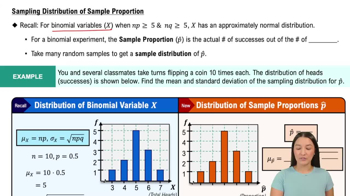Determine the level of measurement of the data listed on the horizontal and vertical axes in the figure.
Table of contents
- 1. Intro to Stats and Collecting Data1h 14m
- 2. Describing Data with Tables and Graphs1h 55m
- 3. Describing Data Numerically2h 5m
- 4. Probability2h 16m
- 5. Binomial Distribution & Discrete Random Variables3h 6m
- 6. Normal Distribution and Continuous Random Variables2h 11m
- 7. Sampling Distributions & Confidence Intervals: Mean3h 23m
- Sampling Distribution of the Sample Mean and Central Limit Theorem19m
- Distribution of Sample Mean - Excel23m
- Introduction to Confidence Intervals15m
- Confidence Intervals for Population Mean1h 18m
- Determining the Minimum Sample Size Required12m
- Finding Probabilities and T Critical Values - Excel28m
- Confidence Intervals for Population Means - Excel25m
- 8. Sampling Distributions & Confidence Intervals: Proportion1h 12m
- 9. Hypothesis Testing for One Sample3h 29m
- 10. Hypothesis Testing for Two Samples4h 50m
- Two Proportions1h 13m
- Two Proportions Hypothesis Test - Excel28m
- Two Means - Unknown, Unequal Variance1h 3m
- Two Means - Unknown Variances Hypothesis Test - Excel12m
- Two Means - Unknown, Equal Variance15m
- Two Means - Unknown, Equal Variances Hypothesis Test - Excel9m
- Two Means - Known Variance12m
- Two Means - Sigma Known Hypothesis Test - Excel21m
- Two Means - Matched Pairs (Dependent Samples)42m
- Matched Pairs Hypothesis Test - Excel12m
- 11. Correlation1h 6m
- 12. Regression1h 50m
- 13. Chi-Square Tests & Goodness of Fit1h 57m
- 14. ANOVA1h 57m
1. Intro to Stats and Collecting Data
Intro to Stats
Problem 1.Q.7c
Textbook Question
Identify the sampling technique used in each study. Explain your reasoning.
A study on attitudes about smoking is conducted at a college. The students are divided by class (freshman, sophomore, junior, and senior). Then a random sample is selected from each class and interviewed.
 Verified step by step guidance
Verified step by step guidance1
Step 1: Understand the problem. The goal is to identify the sampling technique used in the study. The key details are that students are divided into groups based on class (freshman, sophomore, junior, senior), and then a random sample is taken from each group.
Step 2: Recall the definition of stratified sampling. Stratified sampling is a technique where the population is divided into subgroups (strata) based on a shared characteristic, and then a random sample is taken from each subgroup.
Step 3: Compare the study's method to the definition of stratified sampling. In this study, the population (students) is divided into subgroups (classes), and a random sample is taken from each subgroup. This matches the definition of stratified sampling.
Step 4: Explain why this is not another sampling technique. For example, it is not simple random sampling because the population is divided into subgroups before sampling. It is not cluster sampling because the entire subgroup is not selected; only a random sample from each subgroup is chosen.
Step 5: Conclude that the sampling technique used in this study is stratified sampling, as the population is divided into strata (classes) and random samples are taken from each stratum.
 Verified video answer for a similar problem:
Verified video answer for a similar problem:This video solution was recommended by our tutors as helpful for the problem above
Video duration:
6mPlay a video:
Was this helpful?
Key Concepts
Here are the essential concepts you must grasp in order to answer the question correctly.
Stratified Sampling
Stratified sampling is a technique where the population is divided into distinct subgroups, or strata, that share similar characteristics. In the given study, students are categorized by their class year (freshman, sophomore, junior, senior), and a random sample is taken from each class. This method ensures that each subgroup is represented in the sample, which can lead to more accurate and generalizable results.
Recommended video:

Sampling Distribution of Sample Proportion
Random Sampling
Random sampling is a method where each member of a population has an equal chance of being selected for the sample. In the study, after dividing students into classes, a random sample is chosen from each class. This approach minimizes selection bias and helps ensure that the sample reflects the diversity of the entire population, enhancing the validity of the findings.
Recommended video:

Sampling Distribution of Sample Proportion
Sampling Bias
Sampling bias occurs when certain members of a population are systematically more likely to be selected for the sample than others, leading to an unrepresentative sample. In the context of the study, if only one class year was overrepresented or underrepresented, it could skew the results. Understanding this concept is crucial for evaluating the reliability of the study's conclusions about attitudes toward smoking.
Recommended video:

Sampling Distribution of Sample Proportion

 2:13m
2:13mWatch next
Master Introduction to Statistics Channel with a bite sized video explanation from Patrick
Start learningRelated Videos
Related Practice
Textbook Question
1
views
